ODVA announced today the latest enhancements to The EtherNet/IP™ Specification to provide improved network diagnostics, new methods to lower bandwidth and resource requirements for devices, and the addition of IIoT building block infrastructure. “EtherNet/IP’s continued leadership in the industrial communication space will be assured by adding new tools to manage the network, removing roadblocks to adding EtherNet/IP to the simplest of devices, and preparing for TSN with LLDP,” stated Dr. Al Beydoun, President and Executive Director at ODVA.
EtherNet/IP system diagnostics
In addition to the recent enhancements to EtherNet/IP to allow users to obtain device diagnostics pursuant to the NE107 standard, ODVA has enhanced EtherNet/IP further to provide overall system diagnostics. The additional EtherNet/IP system diagnostics will enable a better understanding of the number of connections, resource usage, the number of Ethernet errors, missed packets, and overall CPU utilization.
A common, scalable network diagnostic assembly definition for diagnostic connection points defined by other objects will enable these new statistics to help assist in network troubleshooting. Additionally, new provisions for aggregation of multiple I/O connections will provide a mechanism to multiplex many individual connections into one, which will significantly reduce network bandwidth. Runtime reconfiguration will be seamless and efficiency will be improved across the board, especially in instances where IO-Link or HART translation or modular I/O is utilized.
Enabling UDP-only device communication
Innovative updates to allow for constrained devices running on EtherNet/IP will enable UDP-only device communication with the goal of lowering resource and hardware requirements. Constrained devices are anticipated to significantly lower the cost barrier thereby further strengthening the business case to add EtherNet/IP to in-cabinet, small sensors, and other simple devices.
Ethernet will be possible all the way to edge devices, including use of Single Pair Ethernet (10BASE-T1S), enabling end to end IIoT communication. EtherNet/IP, including CIP Security, has been enhanced to include constrained device definitions. Furthermore, the addition of the option to use Link Layer Discovery Protocol (LLDP) will enable nodes and infrastructure to detect other devices in near proximity, and for the physical network topology to be discovered and visualized.
As a required component for TSN, the addition of LLDP lays the ground work for easier adoption of TSN into the EtherNet/IP Specification. Along with existing network extensions, the TSN standards for sending time critical data via industrial Ethernet will be an option to meet the needs of high determinism applications, to add network design options, and to plan for the significant future increases in data traffic brought about by IT and OT convergence.
The latest enhancements to the EtherNet/IP Specification are enabling enhanced understanding and therefore performance of the broader network, driving EtherNet/IP down to the lowest capacity devices through reducing resource requirements, and are laying the foundation for TSN. ODVA is continuing to drive the advancement of EtherNet/IP to meet the evolving requirements of IIoT and Industry 4.0 to meet the needs of CIP technology users both today and tomorrow.
























































